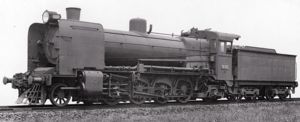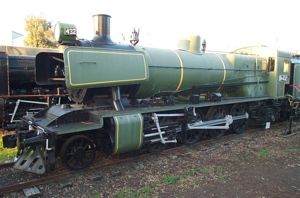Victorian Railways N class
| Victorian Railways N class VR photograph of N class locomotive No. N 110, as built, 1925 | |
| Power type | steam |
|---|---|
| Builder | VR Newport Workshops, North British Locomotive Company |
| Configuration | 2-8-2 |
| Driver size | 55 in (1397 mm) |
| Length | 67 ft 5¼ in (20.55 m) |
| Axle load | 13 t 17 cwt (14.1 t) |
| Weight on drivers | 53 t 2 cwt (54.0 t) |
| Total weight | 124 t 13 cwt (126.7 t) total |
| Tender capacity | 6 t coal (6 t) or 1,500 imp gal (6,800 L) oil, 4,700 gal (21,400 L) water |
| Boiler pressure | 175 psi (1.21 MPa) |
| Fire grate area | 31 ft² (2.9 m²) |
| Heating surface: Total | 1,777 ft² (165.1 m²) |
| Cylinders | 2 |
| Cylinder size | 20×26 in (508×660 mm) |
| Tractive effort | 28,650 lbf (127.4 kN at 85% boiler pressure |
| Number in class | 83 |
The N class was a branch line steam locomotive that ran on Victorian Railways from 1925 to 1966. A development of the successful K class 2-8-0, they were the first VR locomotive designed for possible conversion from 5 ft 3 in (1600 mm) broad gauge to 4 ft 8½ in (1435 mm) standard gauge.
Contents
History
In 1923, in response to the recommendations made by the 1921 Royal Commission on the matter of uniform railway gauge, VR announced a policy that all new locomotive designs were to be capable of conversion from broad to standard gauge.[1] The rationale was that the task of converting VR from broad to standard gauge at a future date would be far easier to achieve if the existing locomotives and rolling stock could be easily modified for standard gauge operation, rather than requiring expensive reengineering or replacement.
The K class 2-8-0 built by VR in 1922-23 was a success, but with a firebox mounted between frames engineered for broad gauge operation only, it was not readily gauge-convertible. Thus when additional branch line locomotives were required, the VR produced a 2-8-2 'Mikado' variant of the K. It retained the same wheels, cylinders, motion, and much of the frame of the K,[2] but featured a longer boiler with a wider, larger grate, mounted above the frames and supported by a trailing truck. The frame itself was engineered for standard gauge, and employed a series of removable spacers and packing blocks to accommodate broad gauge axles.
Despite these design features, no N class locomotive ever ran on standard gauge. By the time the standard gauge Albury to Melbourne mainline opened alongside the existing broad gauge line in 1962, steam locomotives were rapidly being withdrawn from service. Large scale standardisation of Australia's broad gauge rail network did not get underway until 1995, nearly thirty years after the withdrawal of the N class.
Production
Thirty N class locomotives were built by VR's Newport Workshops between 1925 and 1931. A further fifty locomotives were later built by North British Locomotive Company in 1949-50 as part of the postwar rebuilding of Victorian Railways.
A further twenty N class of a modified design were also ordered from Newport Workshops. However, production of this batch ceased in 1951 after three had been built, as VR opted to order more of a new design of 2-8-0 branch line locomotive, the J class. VR also decided to sell ten of the North British-built N class locomotives to South Australian Railways, which was experiencing a motive power shortage, where they became that system's '750 class'. Many of these locomotives had only run a few days in VR service before being transferred to the SAR.
Thus although a total of 83 N class locomotives were built, only 73 were in actual VR service for any substantial period of time.
Had the Newport order been completed, however, there would have been 100 of the class, numbers 400 through 499 (Numbers N433 to N450 were cancelled, although rumor has it that N433 and N 444 were completed, but never ran in service and were cannabilised for parts!)[3]
Regular Service
The N class had an axle load almost as light as that of the K, and as such was able to traverse VR's "light lines", lines built with 60 lb/yd rail.[4] It was however more limited in area of operation than the K, as its wheelbase was too long for the 50 foot turntables used on many branch lines.
Despite the limitation of their longer wheelbase, they were nevertheless widely used on both branch line and main line goods services. Later in their life, N class locomotives were a common sight assisting other locomotives on heavy wheat trains heading for the ports of Geelong or Portland, or shunting in yards such as Ararat.
The ten N class locomotives sold to the SAR saw service on lightly built lines branching from Tailem Bend, however they were apparently unpopular with crews due to their cab design being more cramped than other SAR locomotives.[5]
Interestingly, the SAR 750 class was apparently permitted to run speeds of up to 60 mph (96 km/h),[6] whereas VR limited the N class to a maximum 50 mph (80 km/h).[7]
Design improvements

In 1927, class leader N 110 was equipped with a two cylinder Franklin booster engine which drove the trailing truck axle. Based on the success of this device, VR fitted all but two of the much larger X class 2-8-2s with booster engines. In 1945, N 110's booster was removed and fitted to one of the two non-booster equipped X class locomotives.
During the mid 1930s, the original batch of thirty N class locomotives were equipped with VR's 'Modified Front End' for improved drafting and reduced cylinder back pressure, at which time their original cast iron funnels were replaced by a less ornate "flowerpot" funnel. They also saw other improvements, such as the fitting of cross-compound air compressors and smoke deflectors.
The postwar N class locomotives had a revised boiler design featuring a combustion chamber firebox equipped with thermic siphons.
Demise
The introduction of the T class (EMD G8B) diesel electric locomotive from 1955 onwards on VR's branch line network spelt the beginning of the end for the N class, gradually being retired as successive orders of Ts were delivered throughout the 1950s and into the 1960s. Many were put into storage, used only for seasonal grain traffic.
The end for the N class came in 1966, when the last remaining of the class were withdrawn. N 468 and N 475 hauled an Australian Railway Historical Society special passenger train on 8th October 1966, the final run of the class.[8]
Over the border in South Australia, the new 830 class diesel electrics (ALCO DL531) began to displace branch line steam power. Most of the 750 class was withdrawn by 1962, with locomotive 752 steaming for the last time in November 1964.[9]
Preservation

Despite the relatively large number of N class locomotives built, all but one of the 73 locomotives remaining on the VR after 1951 were scrapped.
N 432, the last of the group of three N locomotives built by Newport Workshops in 1951, is preserved at the ARHS Railway Musuem in North Williamstown, Victoria. As well as its historical value as the only remaining N class locomotive, N 432 is also notable for being the last steam locomotive built by VR's Newport Workshops.
In addition to N 432, one of the ten North British Locomotive Co. built locomotives sold to the SAR also remains. No. 752 is today preserved at the National Railway Museum in Port Adelaide, South Australia.
References
- Dee et al, Power Parade, VicRail Public Relations Division, Melbourne, 1981, ISBN 0-7241-3323-2
- Pearce et al, North Williamstown Railway Musuem, ARHS, Melbourne, 1980, ISBN 0-85849-018-8
- Specific
- ↑ Pearce et al, p. 12
- ↑ Pearce et al, p. 14
- ↑ [1] Third post - retrieved 14th Janurary 2007
- ↑ Victorian Goldfields Railway - History & Preservation - retrieved 23rd October 2006
- ↑ National Railway Museum - Port Adelaide 752 page - retrieved 21st October 2006
- ↑ Railpage SAR Locomotive Data - S.A.R. Broad Gauge (5'3") Steam Locomotives - retrieved 21st October 2006
- ↑ Pearce et al, p. 22
- ↑ Dee et al, p. 29
- ↑ National Railway Museum - Port Adelaide 752 page - retrieved 21st October 2006
External links
- victorianrailways.net N class locomotive page Details and further photographs of N class locomotives
